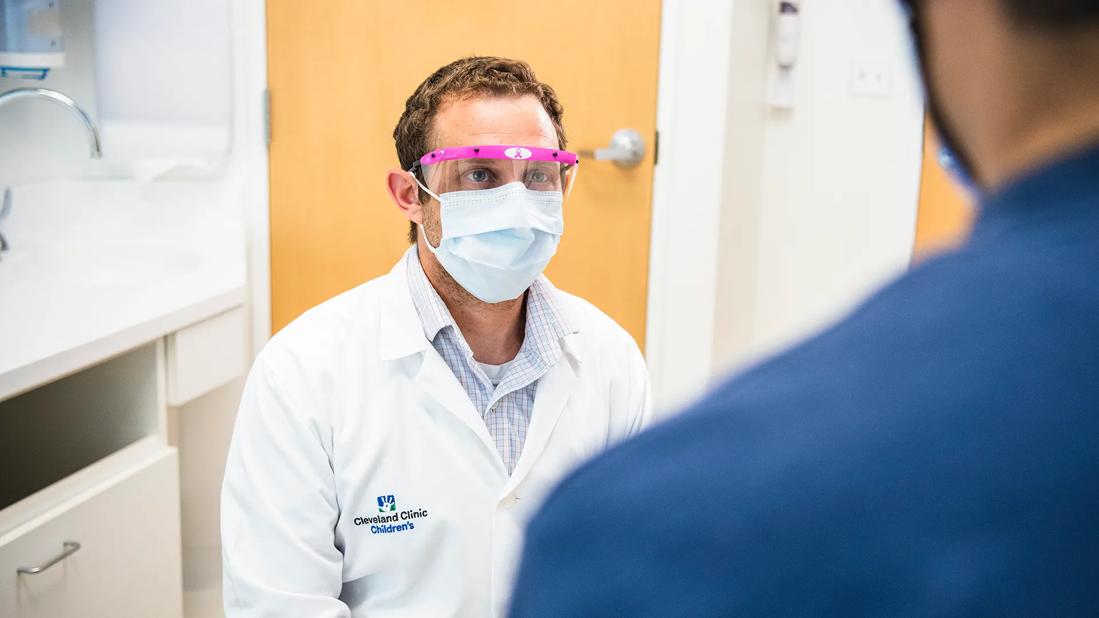Overall survival in patients treated since 2008 is nearly 20% higher than in earlier patients

Pictured above: Pediatric hematologist-oncologist Seth Rotz, MD, was part of a research team that retrospectively studied patients who had bone marrow transplant for Fanconi anemia between 2000 and 2018.
Advertisement
Cleveland Clinic is a non-profit academic medical center. Advertising on our site helps support our mission. We do not endorse non-Cleveland Clinic products or services. Policy
Outcomes of patients with Fanconi anemia bone marrow failure have significantly improved thanks to advances in hematopoietic cell transplantation (HCT), report a team of Cleveland Clinic researchers. This trend, according to data presented at the 2023 American Society of Hematology conference, is the result of reduced treatment-related mortality and graft-failure risk.
“Fanconi anemia, an inherited disorder, is associated with progressive bone marrow failure, leukemia and cancer predisposition,” notes study author Seth Rotz, MD, a pediatric hematologist-oncologist at Cleveland Clinic. “We have seen advances in HCT over the last several decades, and our team set out to better understand the overall impact these developments have had on this patient population.”
Dr. Rotz and colleagues from the Center for International Blood & Marrow Transplant Research (CIBMTR) and other institutions used a CIBMTR database to conduct a retrospective study of children and adults who underwent their first allogeneic HCT for Fanconi anemia bone marrow failure from 2000 to 2018. Patients with myelodysplastic syndromes and acute myeloid leukemia were excluded from this analysis.
The team hypothesized an association between contemporary HCT approaches — such as decreases in radiation and increased use of serotherapy and ex vivo graft manipulation — and improved outcomes in patients with Fanconi anemia who received HCT.
Primary endpoints of this study included overall survival and early subsequent malignant neoplasm. Key secondary endpoints were event-free survival, treatment-related mortality, graft failure, and acute (grade II-IV) and chronic graft-versus-host disease (GvHD).
Advertisement
“Univariate and multivariate Cox regression models were created to evaluate the impact of conditioning, donor and graft source, treatment era, and patient characteristics on outcomes, adjusting for other significant covariates,” explains Dr. Rotz.
Due to confounding factors, researchers were not able to create a single multivariate model that included radiation, ex vivo graft manipulation, and donor and graft source, he notes.
As a result, the researchers performed a subgroup univariate analysis of patients receiving unrelated donor bone marrow or peripheral blood stem cell hematopoietic cell transplantation.
In this study, 646 hematopoietic cell transplantations were analyzed. Of those, 353 were performed between 2000 and 2007 and 293 between 2008 and 2018.
Thirty-five percent of patients (n = 223) had a matched related donor of any graft type, and 38% (n = 244) had an unrelated donor bone marrow or peripheral blood stem cell graft. Additionally, 19% (n = 123) had an unrelated cord blood graft, and 7% (n = 44) had a related haploidentical donor of any graft type.
When comparing the two treatment periods, a significant improvement in five-year overall survival was observed among patients who underwent HCT between 2008 and 2018 (78.8% vs. 62.5%). This trend was driven by lower five-year treatment-related mortality (15.2% vs. 25.5%) as well as lower rates of primary graft failure (7.9% vs. 12.9% at 42 days) and secondary graft failure (4.1% vs. 8.9% at 1 year).
Between the two cohorts, there was no statistically significant change in acute or chronic GvHD or early subsequent malignant neoplasm.
Advertisement
An assessment of the entire cohort revealed that the use of total body irradiation > 300 cGy was associated with lower overall survival and higher treatment-related mortality.
In the overall patient population, there was no association between CD34 selection or T-cell depletion (ex vivo depletion) and improved overall survival, event-free survival or treatment-related mortality. However, it was associated with less acute GvHD and lower (yet not statistically significant) chronic GvHD.
Data also showed that early subsequent malignant neoplasm occurred in 3.2% of study participants by five years post-HCT. While early subsequent malignant neoplasm was associated with chronic GvHD and older age, there was no correlation with ex vivo depletion or use of antithymocyte globulin or alemtuzumab, according to the study authors. Five years is a short period to assess subsequent malignant neoplasm, note the authors, who urge caution when interpreting these results.
Use of total body irradiation did not impact risk of early subsequent malignant neoplasm — however, radiation doses > 300 cGy did.
“Our study shows that, as a field, progress has been made in Fanconi anemia with almost a 20% improvement in overall survival,” says Dr. Rotz. “Secondly, these data demonstrate that higher doses of radiation are associated with harm and should not be used in clinical practice.”
The findings also highlight areas that require more focus, specifically the development of novel strategies to reduce GvHD, he notes.
Advertisement
“Subsequent malignant neoplasms are likely driven, in part, by GvHD and radiation,” he concludes. “So, for patients who undergo transplant, it is important that we ensure they receive adequate long-term surveillance and follow-up for subsequent cancers. These patients are at much higher risk compared to the general population due to their underlying genetic mutation.”
Advertisement
Advertisement

Consult program a valuable tool that benefits both patients and clinicians

Retrospective study yields clues to understanding risk of secondary myeloid neoplasms

Milestone minimally invasive surgeries reduce pain and recovery time

Veteran nurse blends compassion, cutting-edge transplant training and military tradition to elevate patient care

Enhanced visualization and dexterity enable safer, more precise procedures and lead to better patient outcomes

Insights on bringing Cleveland Clinic even closer to becoming the best transplant enterprise in the world

Potentially cost-effective addition to standard GERD management in post-transplant patients

Consensus statement aims to increase use of the perfusion technology and raise transplant volumes